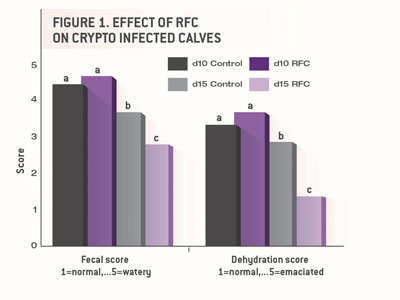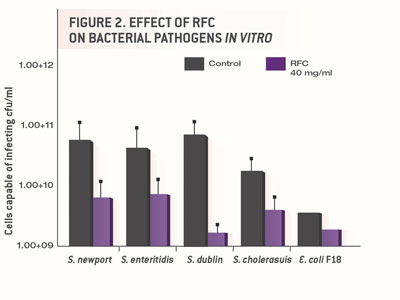
The ABCs of RFCs for Calves
There are no shortcuts when it comes to raising healthy dairy heifer calves.
Strict hygiene of facilities and personnel is a must, as are:
- Proper colostrum management
- Clean, dry bedding
- Good ventilation
- Consistent feed delivery
- Access to good quality water
- Proper nutrition formulated to address the specific needs of a calf’s growth phase
However, that’s not all.
Calf raisers are also learning more about how to better prepare calf immune systems to help these vulnerable animals deal with health challenges when they occur.
We know health challenges will occur, even on the best-managed dairies. The 2007 National Animal Health Monitoring System (NAHMS) for U.S. Dairy reported that 57 percent of weaning calf mortality was due to diarrhea and most cases occurred in calves less than one month old.1
Calf diarrhea, or scours, is not a simple health issue to manage because it is caused by many different pathogens. As a result, calf managers are looking for tools that improve overall calf health so animals can better withstand these insults to their system.
What are RFCs?
Refined functional carbohydrates (RFCs) are a new technology that can help provide that healthy foundation. RFCs are the components harvested from yeast cells (S. cerevisiae) using specific enzymes during the manufacturing process. This enzymatic hydrolysis yields MOS (Mannan Oligosaccharides), (1,3-1,6) beta glucans and D-Mannose.
These compounds are naturally present in all yeast cells, but are not readily bioavailable. The method of processing used to refine the yeast cells influences the size and structure of these liberated components, which in turn, affect bioavailability and functionality. Research2,3,4 shows that each RFC has a specific mode of action and outcome when fed to livestock.
What do RFCs do?
RFCs can help maintain gut health and overall animal health. Since health and production challenges can occur at any time, adding RFCs the calf’s in milk or milk replacer from birth—and throughout the animal’s life cycle—can help improve immune function indirectly preparing it for challenges and directly by providing a defense mechanism for pathogenic bacteria the animal is exposed to.
Since pathogenic challenges are difficult to predict, RFC-feeding can provide the initial defense when these challenges occur. In essence, RFCs bind pathogens, rendering them harmless to the animal. And RFCs act as a prebiotic by feeding the beneficial bacteria of the intestine while blocking sites for attachment by pathogens.
For example, RFCs have been shown to be efficacious when fed to young calves and help reduce scouring caused by Cryptosporidium parvum. RFCs have also been shown to have activity against Eimeria, another scours-causing organism, as well as various types (serovars) of E. coli and Salmonella enterica. These pathogens are those most likely to causes scouring problems on a dairy.
The RFCs bind to the receptors of the Cryptosporidium protozoa (and other pathogens) and prevent it from attaching to the intestinal wall and causing disease. The organisms then pass harmlessly through the digestive system and are excreted. The pathogens remain deactivated, helping to break their life-cycle, helping to reduce the odds of reinfection.
Research highlighted in the chart below (Figure 1) shows that calves fed RFCs recover faster than those that do not receive RFCs.


a,b,c Indicate significant difference (P<0.05). The bars on this chart represent standard deviation.
As the saying goes, an ounce of prevention is worth a pound of cure. Researchers and veterinarians agree that management and control of calf diarrhea before an outbreak is more cost-efficient than treating sick animals after the outbreak occurs. Although many enteric pathogens are involved in calf diarrhea, infection and transmission is always accomplished via a fecal-oral route. Thus care must be taken to prevent pathogen transmission.1
Since pathogens are found in every environment, setting calves up for success must be a key management focus. That means following good pen and feeding hygiene, and enhancing gut health so that animals can more easily stave off infections when they come in contact with pathogens.
Likewise, RFCs help negate the negative effects of mycotoxins that sometimes occur in feed. Just as with pathogens, RFCs bind to these toxins—like aflatoxin—and prevent them from being absorbed through the gut and into the blood circulation. The toxins then pass harmlessly through the digestive system and are excreted.
Growth Benefits
RFCs offer additional benefits. Because calves are healthier, they can spend their energy on growth. Since RFCs are removing challenges to the immune system—more energy is available for gaining weight and frame size, and is not being used by the immune system or fighting a pathogenic infection that causes diarrhea. As a result, the multi-functional nature of RFCs (reducing the effects of harmful pathogens, as well as toxins in feed) synergistically helps the calves partition energy to growth.
This may lead to an improvement in calf growth and performance,7-10 offering dairies an excellent health-enhancing tool when developing a strategy for improved production. Figure 3 shows that calves fed RFCs improved weight gain by as much as 8 pounds compared to the control groups.

While RFCs might have been an unfamiliar term to you a few minutes ago, it’s a new technology that warrants further investigation. Consider RFCs as a means to jump-starting calves’ immunity in a way that provides numerous benefits to animal health, enhanced performance and increased productivity.
1 Cho Y, Yoon K. An overview of calf diarrhea - infectious etiology, diagnosis, and intervention. J of Vet Sci. 2014 Mar; 15(1): 1–17.
2 Hashim A, Mulcahy G, Bourke B, Clyne M. Interaction of Cryptosporidium hominis and Cryptosporidium parvum with Primary Human and Bovine Intestinal Cells. Infection and Immunology 2006;74(1):99.
3 Nocek J, Holt MG, Oppy J. Effects of supplementation with yeast culture and enzymatically hydrolyzed yeast on performance of early lactation dairy cattle. J Dairy Sci 2011;94:4046-4056.
4 Baines D, Erb S, Turkington K, Kuldau G, Juba J, Masson L, Mazza A, Roberts R. Mouldy feed, mycotoxins and Shiga toxin - producing Escherichia coli colonization associated with Jejunal Hemorrhage Syndrome in beef cattle. BMC Veterinary Research 2011;7:24.
5 Jalukar S, Nocek JE. Evaluation of enzymatically hydrolyzed yeast in vitro and in vivo for control of Cryptosporidium parvum infections in dairy calves. J Anim Sci 2009; Vol. 87, E-Suppl. 2/J Dairy Sci Vol. 92, E-Suppl. 1. Research Bulletin D-38 and Research Bulletin D-61.
6 Jalukar S, Oppy J, Holt MG. In-vitro assay to evaluate ability of enzymatically hydrolyzed yeast containing MOS to bind enteropathogenic bacteria. Presented at the ASAS/ADSA Midwestern Section Annual Meeting, 2009. Research Bulletin 31 and Research Bulletin 39.
7 Dennis R, Jalukar S. Effect of CELMANAX SCP on calf performance when fed in the milk replacer and grower phase. J Anim Sci 2011; Vol. 89, E-Suppl. 1/J Dairy Sci Vol. 94, E-Suppl. 1. Research Bulletin D-72.
8 Research Bulletin D-71: CELMANAX SCP in dairy calf milk replacers.
9 Research Bulletin D-51: CELMANAX Liquid in dairy calf milk replacers.
10 Research Bulletin D-53: CELMANAX Liquid in dairy calf milk replacers.



